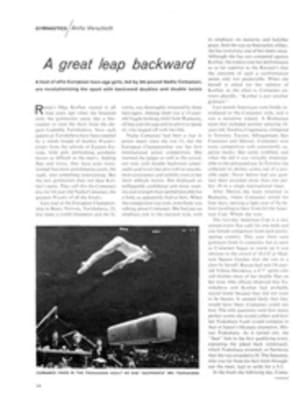
A great leap backward
Russia's Olga Korbut started it all four years ago when she bounced onto the gymnastics scene like a firecracker to steal the show from the elegant Ludmilla Turishcheva. Now such queens as Turishcheva have been toppled by a whole troupe of fearless Wunder-kinder from the schools of Eastern Europe, little girls performing acrobatic moves as difficult as the men's. Adding flips and twists, they have even transformed that most anticlimactic event, the vault, into something entertaining. But the new gymnastics does not bear Korbut's name. They call this the Comaneci era, for 14-year-old Nadia Comaneci, the greatest Wunder of all the Kinder.
Last year at the European Championship in Skien, Norway, Turishcheva, 23, five times a world champion and the favorite, was thoroughly trounced by three teen-agers. Among them was a 13-year-old fragile-looking child from Rumania, all legs and rib cage and no pelvis to speak of, who leaped off with the title.
Nadia Comaneci had been a star in junior meets since she was 11, but the European Championship was her first international senior competition. She stunned the judges as well as the crowd, not only with double backward somersaults and twists but also with an uncommon consistency and stability even in her most difficult moves. She displayed an unflappable confidence and more stamina and strength than seemed possible for a body as apparently frail as hers. When the competition was over, everybody was talking about Comaneci. She had put an emphatic end to the classical style, with its emphasis on maturity and ladylike grace. And she was no firecracker, either; she has won every one of her meets since. Although she has not competed against Korbut, the experts rate her performance as so far superior to the Russian's that the outcome of such a confrontation seems only too predictable. When she herself is asked for her opinion of Korbut, as she often is, Comaneci answers placidly, "Korbut is just another gymnast."
Last month Americans were finally introduced to the Comaneci style, and it was a sensation indeed. A Rumanian team that included another amazing 14-year-old, Teodora Ungureanu, competed in Toronto, Tucson, Albuquerque, San Francisco and Denver. Comaneci won every competition with consistently superior marks. She rarely wobbled, and when she did it was virtually imperceptible to the untrained eye. In Toronto she collected six perfect scores out of a possible eight. Never before had any gymnast been awarded more than one perfect 10 in a single international meet.
After Denver, the team returned to Rumania, where Comaneci rested for four days, nursing a light case of flu before traveling to New York for the American Cup. Which she won.
The two-day American Cup is a new annual event that calls for one male and one female competitor from each participating country. This year there were gymnasts from 11 countries, but as soon as Comaneci began to warm up it was obvious to the crowd of 10,132 at Madison Square Garden that she was in a class by herself. Russia had sent 14-year-old Yelena Davidova, a 4'7" sprite who still finishes most of her double flips on her nose. One official observed that Turishcheva and Korbut had probably stayed home because they did not want to be beaten. It seemed likely that they would have been; Comaneci could not lose. The only questions were how many perfect scores she would collect and how her Tsukahara Vault would compare to that of Japan's Olympic champion, Mitsuo Tsukahara. As it turned out, she "beat" him in the first qualifying event, executing the piked back somersault, which Tsukahara invented, so flawlessly that she was awarded a 10. The Japanese, who was far from his best form throughout the meet, had to settle for a 9.3.
In the finals the following day, Comaneci earned two 9.9s, one 9.95 and another 10 for her whirling floor exercise. "She is a perfectionist," observed Frank Bare, executive director of the U.S. Gymnastics Federation. "She has no weak events." On the uneven parallel bars, one of her most difficult routines includes three free hip circles to a handstand on the high bar, shooting up straight as a knife. "Some girls might do one," said Bare, "and they would do it at a safer angle." For her dismount, she did the Salto Comaneci, as it was named after she first showed it at the European Championship. Letting go of the high bar in a forward motion, she performed a half twist and turned it into a back somersault. Her coach, Bela Karolyi, said that no other girl in the world can do the Salto Comaneci. Ann Carr, one of the best women gymnasts in the U.S., called it "madness."
On the 16-foot beam, Comaneci managed three back handsprings in a row and ended her routine with an aerial cartwheel, a back handspring and a back layout with a double twist. Her floor exercise was as fast-paced as an old silent flick, with a double back somersault for openers and a double twist at the end. "Gosh!" said Carr. "At the end you are supposed to be tired." Comaneci wasn't even breathing hard.
One thing did puzzle the audience: Comaneci never smiled, never flirted with the crowd as Korbut always had. There was fervent applause for her brilliance, but no love affair. "It is not her nature to smile," said a Rumanian woman judge, and Karolyi added, "It is her character to be serious."
Comaneci's large brown eyes, hidden under long bangs, are solemn, perhaps too solemn for a 14-year-old. She answered questions crisply, without elaboration. Has she ever been afraid? "Never." Has she ever cried? "Never." What was the happiest moment in her life? "When I won the European Championship." What is the secret of her success? "I am so good because I work very hard for it." What is her favorite event? "The uneven bars. I can put in more difficulties. It is more challenging." How did she rate her performance in the American Cup? "It was a preparatory step toward the Olympics." Does she enjoy being famous? "It is all right, but I don't want to get too excited about it."
After a crash course in English, she was interviewed for ABC's Wide World of Sports. How are you, Nadia? "Yes, I'm fine." Are you looking forward to the Olympics? "I want for myself gold medal." How many? "Five." Does it bother you to be constantly compared to Olga Korbut? "I'm not Olga Korbut. I'm Nadia Comaneci."
Some say that Comaneci is not human enough, that she is a machine, that she has no emotions. But when she is not the center of attention and feels unwatched, she looks human, all right. She can grin like a child. She can get excited. Her favorite place in the U.S. is Disneyland. And she collects dolls. She has 60 of them, all in national costumes, lined up neatly on a shelf in her room at home.
Home is Onesti, a city of 60,000 in the Carpathian Mountains. It has been renamed Gheorghe Gheorghiu-Dej, after the former premier of Rumania, but everybody still calls it Onesti. Her father is a car mechanic, her mother an office employee and she has a 10-year-old brother, Adrian. The family lives in a new apartment complex downtown, just a five-minute walk from the high school where Comaneci attends morning classes from eight to 12 and trains at the gym every night from five to eight. In between she takes a 2½-hour nap.
Bela Karolyi and his wife Marta, who coach gymnastics at Comaneci's school, selected Nadia with 25 other 6-year-olds from four different kindergartens back in 1968. They have been scouting kindergartens since 1962. "Of course, they have never been exposed to gymnastics at that age," says Karolyi. "We take them to the gym for a test—a 15-meter sprint, a long jump and a walk on the balance beam. If they are afraid on the beam, we send them home right away. We only keep those who like it and show good balance." Karolyi believes that a gymnast's career should last from the age of eight to about 20. "During those years," he says, "there is no fear, there are no problems. Women gymnasts have done so many more difficult feats in recent years because they are younger now. When we select them, we let them warm up to it slowly. We encourage them to participate in other sports as well." In winter, for example, when heavy snowfalls turn Onesti into a ski resort, Comaneci spends her weekends on the slopes.
"But when they are eight," Karolyi continues, "they must be serious about gymnastics. When we took Nadia, she was just normal. I saw nothing fantastic in her on the first day. But in a couple of years she became very serious. Her mental attitude is her great plus. She likes to work. She is always the first to warm up. She does everything I tell her. She has a good character and the ideal body, five feet tall, 86 pounds and perfect proportions." As Frank Bare observes, "Because gymnasts spend so much time in the air it's an advantage not to have so much weight."
At the moment the Karolyis coach 30 girls, half of them Nadia's age, including Ungureanu. She joined the group only three years ago but is rapidly catching up with Comaneci. "The two of them could very well finish one-two in Montreal," says Bare, who is very impressed by Karolyi's approach. "He is a good coach technically, and he is stern. He even tells his girls when, where and what to eat."
There seems to be no friction between Karolyi and his pupils. He does not shout, his girls do not pout. Korbut and her coach Renald Knysh used to glower at each other across the floor. After a mistake or a fall, Korbut would usually sulk and Knysh would ignore her. Comaneci looks at Karolyi for every small gesture. She nods obediently after each bit of advice. At the American Cup, as she was warming up for her floor exercise, she kept landing outside the line on her double back somersaults. Karolyi told her about it. Still, on her next try she again landed too far out. Karolyi repeated his instruction, smiling. Comaneci smiled back, and the next time she landed correctly. When she ripped a sliver of skin from her palm warming up on the uneven parallel bars, she held her bleeding hand out to Karolyi. He told her to spit on it and rub her hands together. Comaneci spat and rubbed until it was time to tackle the bars again for another bit of "madness."
Four years ago, when Korbut started the little girls on this path, the Secretary General of the International Gymnastics Federation, Max Bangerter, branded her style "dangerous acrobatics which could lead to pelvic fractures." The IGF at one point even considered having Korbut's routine banned in an effort to halt the revolution she had so clearly begun. Obviously, it was less than successful. But how much danger does Karolyi feel Comaneci is in, really? "Ah," he says, "but Comaneci never falls."
PHOTO
COMANECI PIKES IN THE TSUKAHARA VAULT AS SHE "OUTPOINTS" MR. TSUKAHARA

